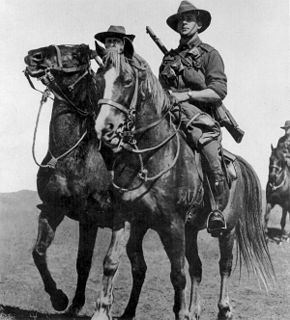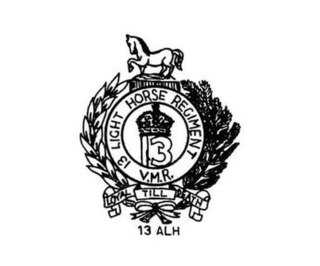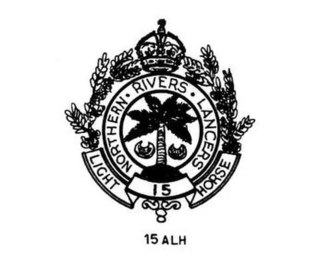
General Sir Henry George Chauvel, was a senior officer of the Australian Imperial Force who fought at Gallipoli and during the Sinai and Palestine Campaign in the Middle Eastern theatre of the First World War. He was the first Australian to attain the rank of lieutenant general and later general, and the first to lead a corps. As commander of the Desert Mounted Corps, he was responsible for one of the most decisive victories and fastest pursuits in military history.
The Australian Mounted Division originally formed as the Imperial Mounted Division in January 1917, was a mounted infantry, light horse and yeomanry division. The division was formed in Egypt, and along with the Anzac Mounted Division formed part of Desert Column, Egyptian Expeditionary Force in World War I. The division was originally made up of the Australian 3rd Light Horse Brigade, the reconstituted 4th Light Horse Brigade, and two British yeomanry brigades; the 5th Mounted Brigade and 6th Mounted Brigade.

The Battle of Beersheba was fought on 31 October 1917, when the British Empire's Egyptian Expeditionary Force (EEF) attacked and captured the Yildirim Army Group garrison at Beersheba, beginning the Southern Palestine Offensive of the Sinai and Palestine campaign of World War I. Infantry from the 60th (London) and the 74th (Yeomanry) Divisions of the XX Corps from the southwest conducted limited attacks in the morning, then the Anzac Mounted Division launched a series of attacks against the strong defences which dominated the eastern side of Beersheba, resulting in their capture during the late afternoon. Shortly afterwards, the Australian Mounted Division's 4th and 12th Light Horse Regiments conducted a mounted infantry charge with bayonets in their hands, their only weapon for mounted attack, as their rifles were slung across their backs. Part of the two regiments dismounted to attack entrenchments on Tel es Saba defending Beersheba while the remainder of the light horsemen continued their charge into the town, capturing the place and part of the garrison as it was withdrawing.

The 1st Light Horse Brigade was a mounted infantry brigade of the Australian Imperial Force (AIF), which served in the Middle Eastern theatre of World War I. The brigade was initially formed as a part-time militia formation in the early 1900s in New South Wales and then later in Queensland. In 1914, the brigade was re-constituted as part of the AIF and was sent to Egypt. Forming part of the New Zealand and Australian Division, during the Gallipoli Campaign it served in a dismounted role between May and December 1915. After being withdrawn to Egypt it served in the Anzac Mounted Division from March 1916 as part of the Egyptian Expeditionary Force, taking part in the Sinai and Palestine Campaign until the end of the war. It was disbanded in 1919. After the war, the AIF light horse regiments were demobilised and disbanded; however, the brigade briefly existed as a part-time militia formation in Queensland until 1921 when its regiments were reorganised into cavalry brigades.

The 2nd Light Horse Brigade was a mounted infantry brigade of the Australian Imperial Force (AIF) which served in the Middle Eastern theatre of World War I. The brigade was initially formed as a part-time militia formation in the early 1900s in New South Wales. In 1914, the brigade was re-constituted as part of the AIF. The brigade first saw action while serving in the Australian and New Zealand Army Corps (ANZAC) during the Gallipoli campaign. After being withdrawn to Egypt in February 1916 they served in the ANZAC Mounted Division from March 1916 as part of the Egyptian Expeditionary Force during the Sinai and Palestine Campaign until the end of the war. After the war, the AIF light horse regiments were demobilised and disbanded; however, the brigade briefly existed as a part-time militia formation in New South Wales until 1921 when its regiments were reorganised into cavalry brigades.

The 3rd Light Horse Brigade was a mounted infantry brigade of the Australian Imperial Force (AIF), which served in the Middle Eastern theatre of World War I. The brigade was initially formed as a part-time militia formation in the early 1900s in Victoria. In 1914, the brigade was re-constituted as part of the AIF. The brigade first saw action while serving with the Australian and New Zealand Army Corps during the Gallipoli campaign where they were noted for their attack during the Battle of the Nek. After being withdrawn to Egypt in February 1916 they were involved in the Sinai and Palestine Campaign until the end of the war. They were attached to a number of different formations being part of the Anzac Mounted Division in March 1916 and the Australian Mounted Division in June 1917, who they remained with until the end of the war. After the war, the AIF light horse regiments were demobilised and disbanded; however, the brigade briefly existed as a part-time militia formation in New South Wales until 1921 when its regiments were reorganised into cavalry brigades.

The 4th Light Horse Brigade was a mounted infantry brigade of the Australian Imperial Force (AIF) serving in the Middle Eastern theatre of World War I. The brigade was initially formed as a part-time militia formation in the early 1900s in Victoria and Tasmania. After the outbreak of World War I, the brigade was raised as a volunteer formation within the AIF in March 1915 and shipped to Egypt and was broken up in August 1915 to provide dismounted reinforcements to other light horse formations already deployed to Gallipoli. Reformed in February 1917, the brigade was assigned to the Imperial Mounted Division, which formed part of the Egyptian Expeditionary Force, and in June 1917 transferred to the Australian Mounted Division, where it served in the Sinai and Palestine Campaign until the end of the war. After the war, the AIF light horse regiments were demobilised and disbanded; however, the brigade briefly existed as a part-time militia formation in New South Wales until 1921 when its regiments were reorganised into cavalry brigades.

The 5th Light Horse Brigade was a mounted infantry brigade of the First Australian Imperial Force (AIF) that served during World War I. The brigade was initially formed as a part-time militia formation in the early 1900s in Queensland. During World War I, the brigade was formed in Palestine in July 1918 following the disbandment of the Imperial Camel Corps. At this time, the brigade consisted of two Australian Light Horse regiments and a French cavalry regiment, and was supported by British and New Zealand artillery and machine gun troops. It served in the Middle Eastern theatre of World War I in the Sinai and Palestine Campaign as part of the Australian Mounted Division, but only saw limited operations before the war ended, taking part in the capture of Damascus in September and October 1918. After the war, the AIF light horse regiments were demobilised and disbanded; however, the brigade briefly existed as a part-time militia formation in Victoria until 1921 when its regiments were reorganised into cavalry brigades.

The 14th Light Horse Regiment was a mounted infantry or light horse unit of the Australian Army. The unit takes its lineage from units raised as part of the colonial forces of the state of Queensland in 1860 and served during the Second Boer War and World War I. In 1930 it was amalgamated with the 2nd Light Horse Regiment to become the 2nd/14th Light Horse Regiment, a unit that continues to exist as part of the Australian Army today.

The 12th Light Horse Regiment was a mounted unit of the Australian Army. It was raised in New South Wales in 1915 as part of the Australian Imperial Force (AIF) for service during the First World War. After fighting at Gallipoli as reinforcements, the regiment served in the Sinai and Palestine campaign against the Ottoman Empire, seeing action in several notable battles including Beersheba, the capture of Jerusalem, Megiddo and the capture of Damascus. In the aftermath of the war, the regiment was used to suppress the 1919 Egyptian Uprising, before being disbanded in late 1919.

The 2nd Light Horse Regiment was a mounted infantry regiment of the Australian Army during the First World War. The regiment was raised in September 1914, and by December as part of the 1st Light Horse Brigade had moved overseas. During the war the regiment only fought against the forces of the Ottoman Empire, in Egypt, at Gallipoli, on the Sinai Peninsula, and in Palestine and Jordan. After the armistice the regiment eventually returned to Australia in March 1919. For its role in the war the regiment was awarded nineteen battle honours.

The 3rd Light Horse Regiment was a mounted infantry regiment of the Australian Army during the First World War. The regiment was raised in September 1914, and by December as part of the 1st Light Horse Brigade had moved overseas. The regiment only fought against the forces of the Ottoman Empire, in Egypt, at Gallipoli, on the Sinai Peninsula, and in Palestine and Jordan. After the armistice the regiment eventually returned to Australia in March 1919. For its role in the war the regiment was awarded nineteen battle honours.

The 4th Light Horse Regiment was a mounted infantry regiment of the Australian Army during the First World War. The regiment was raised in August 1914, as the divisional cavalry regiment for the 1st Division. The regiment fought against the forces of the German Empire and the Ottoman Empire, in Egypt, at Gallipoli, on the Western front, on the Sinai Peninsula, and in Palestine and Jordan. After the armistice the regiment eventually returned to Australia in March 1919. For its role in the war the regiment was awarded twenty-one battle honours.

The 6th Light Horse Regiment was a mounted infantry regiment of the Australian Army during the First World War. The regiment was raised in September 1914, and assigned to the 2nd Light Horse Brigade. The regiment fought against the forces of the German Empire and the Ottoman Empire, in Egypt, at Gallipoli, on the Sinai Peninsula, and in Palestine and Jordan. After the armistice the regiment eventually returned to Australia in March 1919. For its role in the war the regiment was awarded sixteen battle honours. During the inter-war years, the regiment was re-raised as a part-time unit based in New South Wales, adopting the designation of the "New South Wales Mounted Rifles". It was later converted to a motor regiment during the early years of the Second World War before being redesignated as an armoured car regiment. Nevertheless, it was disbanded in early 1943 without having been deployed overseas. During the post war years, the regiment was re-raised as part of the Citizens Military Force, and in 1956 was converted into an infantry unit, and in 1960 was subsumed into the Royal New South Wales Regiment.

The 7th Light Horse Regiment was a mounted infantry regiment of the Australian Army during the First World War. The regiment was raised in October 1914, and assigned to the 2nd Light Horse Brigade. The regiment fought against the forces of the Ottoman Empire, in Egypt, at Gallipoli, on the Sinai Peninsula, and in Palestine and Jordan. After the armistice the regiment eventually returned to Australia in March 1919. For its role in the war the regiment was awarded sixteen battle honours. During the inter-war years, the regiment was re-raised as a part-time unit based in New South Wales. It was later converted to a motor regiment during the Second World War but was disbanded in late 1943 without having been deployed overseas.

The 8th Light Horse Regiment was a mounted rifles regiment of the Australian Army during the First World War. The regiment was raised in September 1914, and assigned to the 3rd Light Horse Brigade. The regiment fought against the forces of the Ottoman Empire, in Egypt, at Gallipoli, on the Sinai Peninsula, and in Palestine and Jordan. After the armistice the regiment eventually returned to Australia in March 1919. For its role in the war the regiment was awarded fifteen battle honours. During the inter-war years, the 8th Light Horse was re-raised as a part-time unit based in the Indi region of northern Victoria. It was later converted to a divisional cavalry regiment during the Second World War but was disbanded in 1944 without having been deployed overseas.

The 9th Light Horse Regiment was a mounted rifles regiment of the Australian Army during the First World War. The regiment was raised in October 1914, and assigned to the 3rd Light Horse Brigade. The regiment fought against the forces of the Ottoman Empire, in Egypt, at Gallipoli, on the Sinai Peninsula, and in Palestine and Jordan. After the armistice the regiment eventually returned to Australia in March 1919. For its role in the war the regiment was awarded fifteen battle honours.

The 13th Light Horse Regiment was a mounted infantry regiment of the Australian Army during the First World War. The regiment was raised in March 1915, and eventually assigned as the mounted regiment for the Australian Corps. During the war the regiment fought against the forces of the Ottoman Empire, at Gallipoli, and against the German Empire on the Western Front. For its role in the war the regiment was awarded twelve battle honours. In 1921, it was later re-raised as a part-time unit of the Citizens Forces, and was briefly amalgamated with the 19th Light Horse. During the Second World War, the regiment was converted into an armoured regiment, designated the "13th Armoured Regiment", although it was disbanded in late 1943 without seeing action.

The 11th Light Horse Regiment was a mounted infantry regiment of the Australian Army during the First World War. The regiment was raised in August 1914, and assigned to the 4th Light Horse Brigade. The regiment fought against the forces of the Ottoman Empire, in Egypt, at Gallipoli, on the Sinai Peninsula, and in Palestine and Jordan. After the armistice the regiment eventually returned to Australia in March 1919. For its role in the war the regiment was awarded fourteen battle honours. During the inter-war years, the regiment was re-raised as a part-time unit based in the Darling Downs region of Queensland. It was later converted to a motor regiment during the Second World War but was disbanded in 1943 without having been deployed overseas.

The 15th Light Horse Regiment was a mounted infantry regiment of the Australian Army during the First World War. The regiment was raised in Palestine in 1918, from soldiers that had been serving with the Imperial Camel Corps Brigade, and assigned to the 5th Light Horse Brigade. During the war the regiment fought against the forces of the Ottoman Empire, in the Sinai and Palestine Campaign and was awarded fourteen battle honours. During the inter-war years, the regiment was re-raised as a part-time unit based in the Northern Rivers region of New South Wales. It was later converted to a motor regiment during the Second World War but was disbanded in 1944 without having been deployed overseas. In the post war period, the regiment was briefly re-formed, before being amalgamated into the 1st/15th Royal New South Wales Lancers in 1956.






















